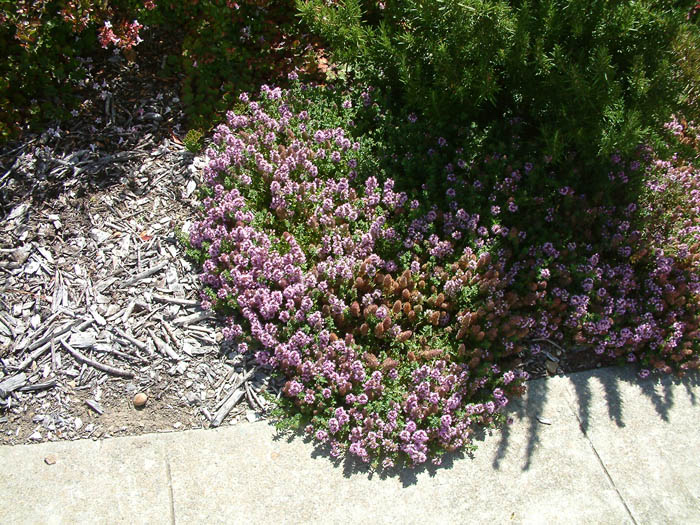Thymus serpyllum
Mother of Thyme, creeping thyme

Description
This attractive and reliable groundcover is so dense that it can smother out weeds. It reaches 3" tall and spreads 30". Leaves are tiny and dark green. Can tolerate some foot traffic. Tiny pink flowers appear in summer. This plant is great for a rock or Mediterranean style garden. It prefers full to part sun and has low water requirements once it's established. It will cover adjacent sidewalks and rocks. Bees love this plant too.
Maintenance Tips
Thymus serpyllum is a very low-growing, creeping plant. It is not used for culinary purposes but it makes an excellent ornamental ground cover. This is a very low-maintenance plant if it is planted in ideal conditions. It is drought tolerant and prefers full sun but can thrive in any soil condition. During the cooler, wetter months, the excess moisture can cause the plant to lose leaves and thin out. It is susceptible to root rot, mostly in the warmer months when people tend to overwater. If symptoms of root rot are present, stop watering and allow the soil to dry out. If the problem is killing off the plant, a systemic fungicide can be applied to treat the disease.
Plant Type
Ground cover
Height Range
Under 1'
Flower Color
Pink
Flower Season
Summer
Leaf Color
Dark Green
Bark Color
n/a
Fruit Color
n/a
Fruit Season
n/a
Sun
Full, Half
Water
Low
Growth Rate
Fast
Soil Type
Unparticular
Soil Condition
Well-drained, Dry
Soil pH
Acid, Neutral, Basic
Adverse Factors
Attracts Bees
Design Styles
English Cottage, Formal, Meadow, Mediterranean, Ranch, Spanish, Woodland
Accenting Features
Showy Flowers, Unusual Foliage
Seasonal Interest
Winter, Spring, Summer, Fall
Location Uses
Entry, Lawn, Parking Strip, Patio, Walkways, With Rocks
Special Uses
Erosion Control, Filler, Mass Planting, Lawn Substitute, Naturalizing
Attracts Wildlife
n/a
Water Saving Tip:
Water between sunset and sunrise when temperatures and wind are the lowest.